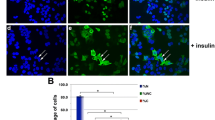Abstract
MIER1 is a transcriptional regulator that exists as several isoforms. Of particular interest is the MIER1α isoform, which contains in its unique C-terminus an LXXLL motif for interaction with nuclear hormone receptors. Indeed, MIER1α has been shown to interact with ERα and inhibit estrogen-stimulated growth of breast carcinoma cells. Moreover, the subcellular localization of MIER1α changes dramatically, from nuclear to cytoplasmic, during progression to invasive breast carcinoma. While human MIER1 RNA and protein expression pattern data have been posted on several websites, none of these studies use probes or antibodies that distinguish between the α and β isoforms. We report here the first immunohistochemical study of the MIER1α protein expression pattern in human tissues. Our analysis revealed intense staining of specific cell types within virtually every endocrine and reproductive tissue except for the thyroid gland. In particular, we detected intense staining of ovarian follicles and germinal epithelium, ductal epithelial cells of the breast, pancreatic islet cells, all areas of the anterior pituitary and all zones of the adrenal cortex; moderate staining of germ cells and Leydig cells within the testis, patches of chromaffin cells in the adrenal medulla and weak staining of the fibromuscular stroma within the prostate. Immunoreactivity was limited to the cytoplasm in all positive cells except for oocytes and germinal epithelial cells in which the nucleus was also stained and in ductal epithelial cells of the breast in which staining was exclusively nuclear. In general, non-endocrine tissues were negative, however a few exceptions were noted. These included hepatocytes, myocardial fibers and neurons in all regions of the brain examined, with the exception of the thalamus. Neuronal staining was restricted to the cell bodies and dendrites, as most axons were negative. These data suggest that human MIER1α functions specifically in endocrine tissues and in a limited number of non-endocrine organs.







Similar content being viewed by others
References
Blackmore TM, Mercer CF, Paterno GD, Gillespie LL (2008) The transcriptional cofactor MIER1-beta negatively regulates histone acetyltransferase activity of the CREB-binding protein. BMC Res Notes 1:68
Clements JA, Mercer FC, Paterno GD, Gillespie LL (2012) Differential splicing alters subcellular localization of the alpha but not beta isoform of the MIER1 transcriptional regulator in breast cancer cells. PLoS ONE 7(2):e32499
Ding Z, Gillespie LL, Paterno GD (2003) Human MI-ER1 alpha and beta function as transcriptional repressors by recruitment of histone deacetylase 1 to their conserved ELM2 domain. Mol Cell Biol 23(1):250–258
Ding Z, Gillespie LL, Mercer FC, Paterno GD (2004) The SANT domain of human MI-ER1 interacts with Sp1 to interfere with GC box recognition and repress transcription from its own promoter. J Biol Chem 279(27):28009–28016
Jia Z, Zhao W, Fan L, Sheng W (2012) The expression of PCNA, c-erbB-2, p53, ER and PR as well as atypical hyperplasia in tissues nearby the breast cancer. J Mol Histol 43(1):115–120
McCarthy PL, Mercer FC, Savicky MW, Carter BA, Paterno GD et al (2008) Changes in subcellular localisation of MI-ER1 alpha, a novel oestrogen receptor-alpha interacting protein, is associated with breast cancer progression. Br J Cancer 99(4):639–646
Paterno GD, Li Y, Luchman HA, Ryan PJ, Gillespie LL (1997) cDNA cloning of a novel, developmentally regulated immediate early gene activated by fibroblast growth factor and encoding a nuclear protein. J Biol Chem 272(41):25591–25595
Paterno GD, Mercer FC, Chayter JJ, Yang X, Robb JD et al (1998) Molecular cloning of human er1 cDNA and its differential expression in breast tumours and tumour-derived cell lines. Gene 222(1):77–82
Paterno GD, Ding Z, Lew YY, Nash GW, Mercer FC et al (2002) Genomic organization of the human mi-er1 gene and characterization of alternatively spliced isoforms: regulated use of a facultative intron determines subcellular localization. Gene 295(1):79–88
Simoncini T, Fornari L, Mannella P, Varone G, Caruso A et al (2002) Novel non-transcriptional mechanisms for estrogen receptor signaling in the cardiovascular system. Interaction of estrogen receptor alpha with phosphatidylinositol 3-OH kinase. Steroids 67(12):935–939
Simoncini T, Rabkin E, Liao JK (2003) Molecular basis of cell membrane estrogen receptor interaction with phosphatidylinositol 3-kinase in endothelial cells. Arterioscler Thromb Vasc Biol 23(2):198–203
Thorne LB, Grant AL, Paterno GD, Gillespie LL (2005) Cloning and characterization of the mouse ortholog of mi-er1. DNA Seq 16(3):237–240
Thorne LB, McCarthy PL, Paterno GD, Gillespie LL (2008) Protein expression of the transcriptional regulator MI-ER1 alpha in adult mouse tissues. J Mol Histol 39(1):15–24
Wang L, Charroux B, Kerridge S, Tsai CC (2008) Atrophin recruits HDAC1/2 and G9a to modify histone H3K9 and to determine cell fates. EMBO Rep 9(6):555–562
Wilkinson-Berka JL, Alousis NS, Kelly DJ, Gilbert RE (2003) COX-2 inhibition and retinal angiogenesis in a mouse model of retinopathy of prematurity. Invest Ophthalmol Vis Sci 44(3):974–979
Acknowledgments
This work was supported by a grant to LLG and GDP from the Canadian Institutes of Health Research (MOP-97938).
Author information
Authors and Affiliations
Corresponding author
Rights and permissions
About this article
Cite this article
McCarthy, P.L., Paterno, G.D. & Gillespie, L.L. Protein expression pattern of human MIER1 alpha, a novel estrogen receptor binding protein. J Mol Hist 44, 469–479 (2013). https://doi.org/10.1007/s10735-012-9478-z
Received:
Accepted:
Published:
Issue Date:
DOI: https://doi.org/10.1007/s10735-012-9478-z




